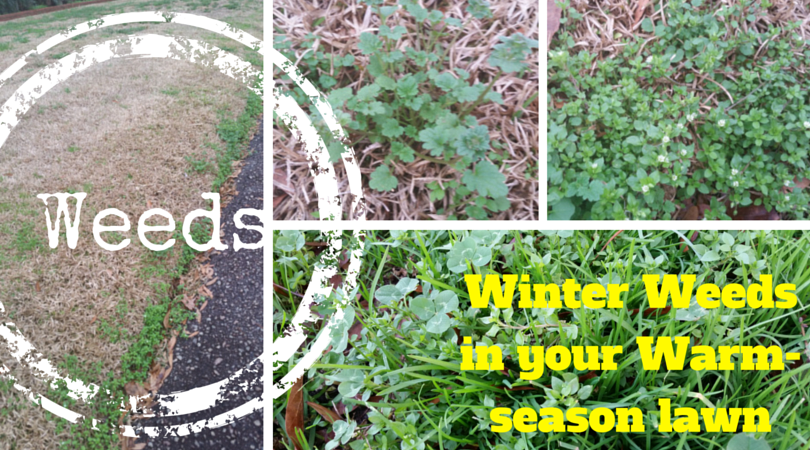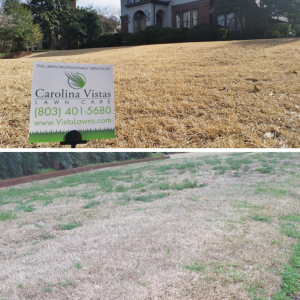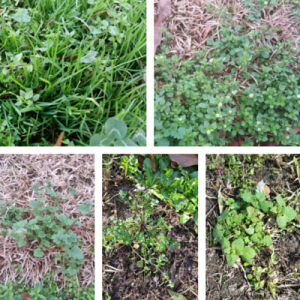
Most lawns in the Midlands of South Carolina are made up of warm-season turfgrasses. These warm-season grasses enter dormancy in the fall, when temperatures begin to drop, and generally do not begin to green-up again until the warmer spring months. That means that the healthiest warm-season lawns usually have a uniform tan/brown color during the winter. If you live in the Midlands and you have some green in your lawn during the winter months, chances are you have winter lawn weeds invading your turf.

Top: dormant lawn with no weeds present (Columbia) Bottom: dormant lawn with winter weeds (Columbia)
Some people don’t care much for the straw-like color of dormant or semi-dormant warm-season lawns. However, in my experience, this is often because of winter weeds that interrupt the otherwise aesthetically pleasing uniformity of a healthy, dormant turf. Lawn weeds are especially troublesome during the cooler months because they are very noticeable and very active. In fact, just a few winter weeds can quickly become a bigger problem, especially when milder winter weather prevails.
It is not uncommon in South Carolina to have extended periods of mild winter temperatures with some rainfall. These conditions are usually not enough to promote active growth of dormant turfgrasses, but lawn weeds can become very active and can spread quickly. This is especially true in areas with thin grass coverage. The best defense against weed development in your lawn is to promote a thick, healthy turf. For this reason, a good lawn care program is vital to keeping weeds out of your lawn. Part of a healthy lawn care program includes the responsible use of pre-emergent and post-emergent herbicides.
Winter annual weeds, such as Poa annua (annual bluegrass), chickweed, henbit, bittercress, and deadnettle germinate in the fall and grow through the winter. They flower and set seed in the spring, before dying out, often leaving bare or thin areas in the lawn where weed density was high. Winter annual weeds can be very competitive, robbing your grass of nutrients, light and water. If you’ve had trouble in the past with winter annuals in your lawn, you are likely to have trouble with them in the future because of the seeds that they produce. Most of these weeds can be controlled with pre-emergent herbicides in the fall and post-emergent herbicides in the winter and spring.
Pre-emergent herbicides work by stopping the development of annual weeds from seed, as they germinate. Proper use of pre-emergent herbicides depends largely on the target weed and timing. Weather conditions play an important role in determining when to apply pre-emergents to control winter annuals. However, here in the Midlands, mid-September is a good rule of thumb. Once winter annual weeds have had a chance to germinate and start developing – usually by late fall/early winter – a post-emergent herbicide is needed to control these weeds.
Post-emergent weed control products can be used during the winter and spring to control most winter annual weeds that have already germinated and are actively growing in your lawn. These products can also be effective for controlling many cool-season perennial weeds in warm-season lawns. Perennial weeds have a longer life cycle than annuals, as they continue to grow over the course of many seasons. In addition to sometimes reproducing from seed, they often reproduce from vegetative parts like roots, bulbs, tubers, stolons and rhizomes. Some examples of common cool-season perennial weeds in South Carolina lawns include white clover, wild garlic, wild onion, and florida betony.
As I mentioned above, timing is important when using any herbicides to control weeds in your lawn. Pre-emeregents should be applied in the fall for control of winter weeds, however, they can also be used in early spring to help control summer annuals like lespedeza, spotted spurge, crabgrass and goosegrass. Post-emergent herbicides are most effective when the target weed(s) are actively growing, so it is important to know the life-cycle of the weeds you are trying to control, as well as the effects that weather and cultural practices like mowing have on herbicide efficacy.
Responsible use of herbicides can be very effective when dealing with weeds in your lawn, but remember that the best weed control comes from promoting a thick and healthy turf. Implementing a program that includes best management practices such as proper mowing and watering, balanced and turf-specific fertilization, soil testing and conditioning, insect and disease control, in addition to using herbicides at the appropriate times will help to ensure that your lawn is thick and healthy. A dense, vigorous lawn will out-compete most weeds, so be sure to enhance the health and appearance of your lawn with a sound lawn care program!Â
People often ask me, “when is the best time of year to start a lawn care program?” The answer is always now. A Carolina Vistas Lawn Care program will provide your lawn with the appropriate weed control, fertilization and care it needs, when it needs it. For more information about winter lawn weeds, feel free to contact us. We would be happy to provide you with our complimentary lawn analysis. Also, you might consider checking out our FAQ’s for help with service questions or lawn care questions.
